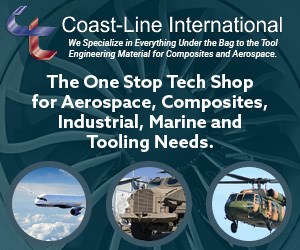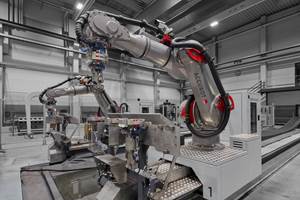Episode 50: Markus Rufer, Scorpius Space Launch Co.
In this episode of CW Talks, CW interviews Scorpius Space Launch Co. CEO Markus Rufer about the company’s all-composite cryogenic pressure vessels and their role in a range of applications, including recent and upcoming lunar lander missions.

Markus Rufer, Scorpius Space Launch Co. Source | CW
In this latest installment of CW Talks, the composites podcast, CW interviews Markus Rufer from Scorpius Space Launch Co. (SSLC, Torrance, Calif., U.S.) about its Type 5 carbon fiber composite pressure vessels, recently used in two lunar lander missions for Intuitive Machines (IM, Houston, Texas, U.S.), one of the providers in NASA’s (Washington, D.C., U.S.) Commercial Lunar Payload Delivery Services (CLPS) initiative.
SSLC has built 150-200 tanks over 15 years. The company’s cryogenic tanks enable the use of greener propellants for space missions as well as offering advancements in energy storage and medical applications. Rufer discusses the company’s aims to integrate tanks into the spacecraft structure, reducing parts and weight. He also offers insights into work SSLC is pursuing with applications in medical and other industries, highlighting its cryogenic technology’s versatility.

The Intuitive Machines (IM) Nova-C lander is equipped with two SSLC Pressurmaxx tanks that enable its LO2/LCH4 propulsion system. Source | Intuitive Machines
CompositesWorld (CW): SSLC’s Type 5 pressure vessels were recently featured on two successful lunar landings. Can you give an an update?
Markus Rufer (MR): This was a long dreamed-of breakthrough. We started this work really early, and I believe we can say rightfully that we have pioneered the Type 5 technology, which, as you know, is an all-composite structure that does not have any liner or metallic materials in it. We have now progressed, advanced and evolved this technology over a 15-year term during which we built 150-200 tanks for all kinds of applications.
Intuitive Machines [IM] was looking for a solution for their Nova-C lander — and had a lot of the systems and components ready to go — but had not found a good solution for their propellant, which was liquid methane and liquid oxygen. They were looking for a system that could do the cryogenic work. And that’s been a challenge in space for a lot of companies. There is a desire to have a cleaner system, fuels and propellants that are readily available and inexpensive and non-toxic in the broader sense. IM sought us out and ended up very quickly selecting us to be the providers for these tank systems.
These vessels are 51-52 inches in diameter, about 40 inches long. I don’t want to call them a pancake tank — as some people call these kinds of short and fat tanks — but it is a short tank. It is all-composite, and contains all the systems that manage propellant.
We had the chance in February 2024 to successfully support the IM-1 mission. For us that meant a tremendous boost in how we get through all the qualifications. How do we satisfy what NASA requires? What did SpaceX need for us to sit on the Falcon 9? And so there’s a lot of risk to mitigate. We were on a pathfinding mission, to a degree, because some of these permits and certificates did not exist before this first lunar mission and IM did a tremendous job performing somewhere between 150-200 tests in over a year — typical temperature cycling, pressure, shock and vibration, and all kinds of compatibility issues. So we pretty much did all of it on the first try. We did not have a lot of U-turns, and were able to support the first mission last year. Our tanks performed flawlessly. That was incredibly rewarding for our team.
CW: Can you explain what sets Scorpius tanks apart from some of the other pressure vessels that are being used for space missions? You have your sights set on a larger objective for your tanks, where you are interested in having these tanks function also as load-bearing structures, part of the vehicles themselves. Can you talk a bit about that functionality that you’re working to achieve, and what makes your tanks different?
(MR): I can give you a two-part answer here, because it’s kind of a two-part question.
What is often used in space is called the COPV [carbon overlap pressure vessel], a tank with an inner shell that’s made of some metal. That’s your leak barrier that contains a gas or a fluid, and surrounding it are wound carbon fibers to make it really strong without gaining a lot of mass. That approach still works today, and in many cases is a reliable solution.
Where we [SSLC] begin to break away from that is when cryogenic fluids come into play — oxidizers in particular. We want to go to higher-performing propellants, but we also want to get cleaner and what happens when you go really cold? Your inner shell, which is made of metal, wants to shrink, and the surrounding material does not quite follow that curve the same way. This can lead to delamination and other phenomenon caused by having these dissimilar materials.
We found a way to eliminate the failure source that we’ve seen in the space business — these liner-related failures. We were looking for a solution where you could make one tank out of one material, all throughout, not using any metals. It’s a continuous build. There are no materials fighting themselves internally because they have different properties. We also have no corrosion issues with composite materials.
We also wanted to see if we could use this technology to make more of a unibody structure — a tank that has internal and external features. The idea is to have structures that are a part of the tank wall that hold your batteries, your cables, your computers and other components. So that’s where we think we can offer a game-changing approach to things, where the tank isn’t just another component that you put on a scale and all it will do is hold a gas or a fluid. Now the tank becomes your unibody chassis.
Learn more about Scorpius Space Launch Co. and its Type 5 carbon fiber pressure vessels in this CW feature story.
Related Content
Orbital Composites wins award from U.S. Space Force to build space factories for antennas
Partners Axiom Space, Northrop Grumman Space Logistics and Southwest Research Institute will help advance ISAM technologies for kilometer-scale LEO antennas, space stations and GEO applications, targeting space factory in 3-5 years.
Read MoreAutomated robotic NDT enhances capabilities for composites
Kineco Kaman Composites India uses a bespoke Fill Accubot ultrasonic testing system to boost inspection efficiency and productivity.
Read MoreComposites end markets: New space (2025)
Composite materials — with their unmatched strength-to-weight ratio, durability in extreme environments and design versatility — are at the heart of innovations in satellites, propulsion systems and lunar exploration vehicles, propelling the space economy toward a $1.8 trillion future.
Read MoreNASA launches composite solar sail into space
Sunlight-based propulsion system, supported by carbon fiber-reinforced booms, will undergo weeks-long testing to demonstrate and verify its capabilities.
Read MoreRead Next
Composites end markets: New space (2025)
Composite materials — with their unmatched strength-to-weight ratio, durability in extreme environments and design versatility — are at the heart of innovations in satellites, propulsion systems and lunar exploration vehicles, propelling the space economy toward a $1.8 trillion future.
Read MoreBraided thermoplastic composite H2 tanks with co-consolidated molded boss areas to fit EV battery space
BRYSON project demonstrates possible designs, automated manufacturing and low permeability concepts, including EVOH liner and novel PPA matrix.
Read MoreAll-recycled, needle-punched nonwoven CFRP slashes carbon footprint of Formula 2 seat
Dallara and Tenowo collaborate to produce a race-ready Formula 2 seat using recycled carbon fiber, reducing CO2 emissions by 97.5% compared to virgin materials.
Read More

























